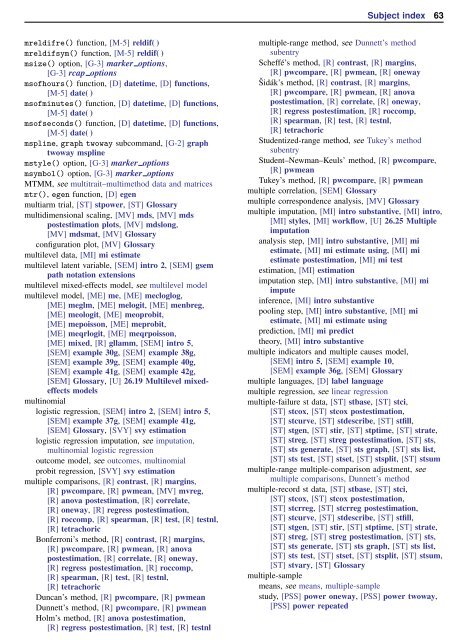Subject index - Stata
Subject index - Stata
Subject index - Stata
You also want an ePaper? Increase the reach of your titles
YUMPU automatically turns print PDFs into web optimized ePapers that Google loves.
<strong>Subject</strong> <strong>index</strong> 63<br />
mreldifre() function, [M-5] reldif( )<br />
mreldifsym() function, [M-5] reldif( )<br />
msize() option, [G-3] marker options,<br />
[G-3] rcap options<br />
msofhours() function, [D] datetime, [D] functions,<br />
[M-5] date( )<br />
msofminutes() function, [D] datetime, [D] functions,<br />
[M-5] date( )<br />
msofseconds() function, [D] datetime, [D] functions,<br />
[M-5] date( )<br />
mspline, graph twoway subcommand, [G-2] graph<br />
twoway mspline<br />
mstyle() option, [G-3] marker options<br />
msymbol() option, [G-3] marker options<br />
MTMM, see multitrait–multimethod data and matrices<br />
mtr(), egen function, [D] egen<br />
multiarm trial, [ST] stpower, [ST] Glossary<br />
multidimensional scaling, [MV] mds, [MV] mds<br />
postestimation plots, [MV] mdslong,<br />
[MV] mdsmat, [MV] Glossary<br />
configuration plot, [MV] Glossary<br />
multilevel data, [MI] mi estimate<br />
multilevel latent variable, [SEM] intro 2, [SEM] gsem<br />
path notation extensions<br />
multilevel mixed-effects model, see multilevel model<br />
multilevel model, [ME] me, [ME] mecloglog,<br />
[ME] meglm, [ME] melogit, [ME] menbreg,<br />
[ME] meologit, [ME] meoprobit,<br />
[ME] mepoisson, [ME] meprobit,<br />
[ME] meqrlogit, [ME] meqrpoisson,<br />
[ME] mixed, [R] gllamm, [SEM] intro 5,<br />
[SEM] example 30g, [SEM] example 38g,<br />
[SEM] example 39g, [SEM] example 40g,<br />
[SEM] example 41g, [SEM] example 42g,<br />
[SEM] Glossary, [U] 26.19 Multilevel mixedeffects<br />
models<br />
multinomial<br />
logistic regression, [SEM] intro 2, [SEM] intro 5,<br />
[SEM] example 37g, [SEM] example 41g,<br />
[SEM] Glossary, [SVY] svy estimation<br />
logistic regression imputation, see imputation,<br />
multinomial logistic regression<br />
outcome model, see outcomes, multinomial<br />
probit regression, [SVY] svy estimation<br />
multiple comparisons, [R] contrast, [R] margins,<br />
[R] pwcompare, [R] pwmean, [MV] mvreg,<br />
[R] anova postestimation, [R] correlate,<br />
[R] oneway, [R] regress postestimation,<br />
[R] roccomp, [R] spearman, [R] test, [R] testnl,<br />
[R] tetrachoric<br />
Bonferroni’s method, [R] contrast, [R] margins,<br />
[R] pwcompare, [R] pwmean, [R] anova<br />
postestimation, [R] correlate, [R] oneway,<br />
[R] regress postestimation, [R] roccomp,<br />
[R] spearman, [R] test, [R] testnl,<br />
[R] tetrachoric<br />
Duncan’s method, [R] pwcompare, [R] pwmean<br />
Dunnett’s method, [R] pwcompare, [R] pwmean<br />
Holm’s method, [R] anova postestimation,<br />
[R] regress postestimation, [R] test, [R] testnl<br />
multiple-range method, see Dunnett’s method<br />
subentry<br />
Scheffé’s method, [R] contrast, [R] margins,<br />
[R] pwcompare, [R] pwmean, [R] oneway<br />
Šidák’s method, [R] contrast, [R] margins,<br />
[R] pwcompare, [R] pwmean, [R] anova<br />
postestimation, [R] correlate, [R] oneway,<br />
[R] regress postestimation, [R] roccomp,<br />
[R] spearman, [R] test, [R] testnl,<br />
[R] tetrachoric<br />
Studentized-range method, see Tukey’s method<br />
subentry<br />
Student–Newman–Keuls’ method, [R] pwcompare,<br />
[R] pwmean<br />
Tukey’s method, [R] pwcompare, [R] pwmean<br />
multiple correlation, [SEM] Glossary<br />
multiple correspondence analysis, [MV] Glossary<br />
multiple imputation, [MI] intro substantive, [MI] intro,<br />
[MI] styles, [MI] workflow, [U] 26.25 Multiple<br />
imputation<br />
analysis step, [MI] intro substantive, [MI] mi<br />
estimate, [MI] mi estimate using, [MI] mi<br />
estimate postestimation, [MI] mi test<br />
estimation, [MI] estimation<br />
imputation step, [MI] intro substantive, [MI] mi<br />
impute<br />
inference, [MI] intro substantive<br />
pooling step, [MI] intro substantive, [MI] mi<br />
estimate, [MI] mi estimate using<br />
prediction, [MI] mi predict<br />
theory, [MI] intro substantive<br />
multiple indicators and multiple causes model,<br />
[SEM] intro 5, [SEM] example 10,<br />
[SEM] example 36g, [SEM] Glossary<br />
multiple languages, [D] label language<br />
multiple regression, see linear regression<br />
multiple-failure st data, [ST] stbase, [ST] stci,<br />
[ST] stcox, [ST] stcox postestimation,<br />
[ST] stcurve, [ST] stdescribe, [ST] stfill,<br />
[ST] stgen, [ST] stir, [ST] stptime, [ST] strate,<br />
[ST] streg, [ST] streg postestimation, [ST] sts,<br />
[ST] sts generate, [ST] sts graph, [ST] sts list,<br />
[ST] sts test, [ST] stset, [ST] stsplit, [ST] stsum<br />
multiple-range multiple-comparison adjustment, see<br />
multiple comparisons, Dunnett’s method<br />
multiple-record st data, [ST] stbase, [ST] stci,<br />
[ST] stcox, [ST] stcox postestimation,<br />
[ST] stcrreg, [ST] stcrreg postestimation,<br />
[ST] stcurve, [ST] stdescribe, [ST] stfill,<br />
[ST] stgen, [ST] stir, [ST] stptime, [ST] strate,<br />
[ST] streg, [ST] streg postestimation, [ST] sts,<br />
[ST] sts generate, [ST] sts graph, [ST] sts list,<br />
[ST] sts test, [ST] stset, [ST] stsplit, [ST] stsum,<br />
[ST] stvary, [ST] Glossary<br />
multiple-sample<br />
means, see means, multiple-sample<br />
study, [PSS] power oneway, [PSS] power twoway,<br />
[PSS] power repeated

















